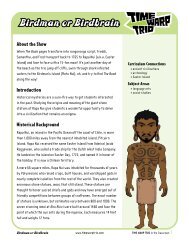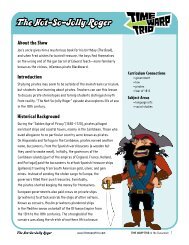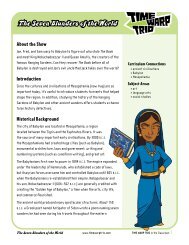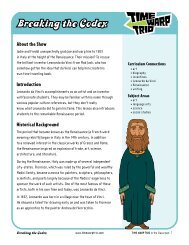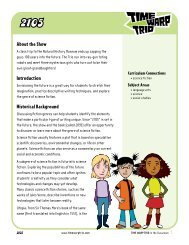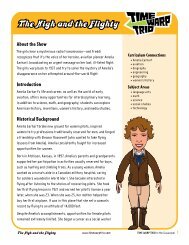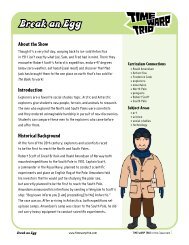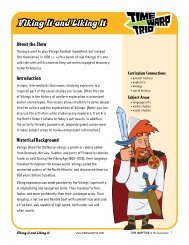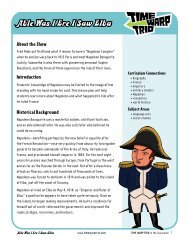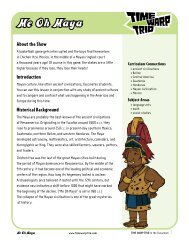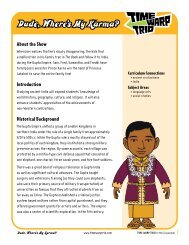You also want an ePaper? Increase the reach of your titles
YUMPU automatically turns print PDFs into web optimized ePapers that Google loves.
<strong>Wushu</strong> <strong>Were</strong> <strong>Here</strong><br />
About the Show<br />
Sam gets trapped inside The Book, and Anna, Fred, and Joe travel<br />
back to the Tang dynasty in China in 621 C.e. to figure out how to get<br />
him out. En route they help the Shaolin Monks rescue General Li Shimin<br />
from prison, travel past the beginnings of the Great Wall, learn about<br />
the teachings of Zen Buddhism, and come face to face with the evil<br />
Mad Jack!<br />
Introduction<br />
Ancient China is a fascinating topic that students may not be familiar<br />
with. In addition to an introduction to the history and culture of China,<br />
students may also be intrigued to learn about the development of<br />
kung fu and other martial arts.<br />
Historical Background<br />
Tang China was one of the greatest empires of the ancient world.<br />
After a period of chaos and division following the collapse of the Han<br />
dynasty in 220 C.e. and reunification under the Sui dynasty, Li Yuan<br />
(Gaozu) established the Tang dynasty. His son, Li Shimin (Taozong),<br />
was a brilliant general who came to power in 627 C.e. During his<br />
26-year reign, trade, the arts, science and technology, and religion<br />
all enjoyed a “golden age” as the empire expanded and prospered.<br />
The capital, Ch’ang-an, where grand palaces and temples were built,<br />
was the largest city in the world at the time. Earlier advances<br />
in China had included paper, silk, the wheelbarrow, the crossbow,<br />
and the magnetic compass. New scientific and technological knowledge<br />
developed. In medicine, Sun Simiao (a famous Daoist priest and<br />
medical expert during the Tang dynasty) documented his extensive<br />
medical knowledge, including treatment with herbs, drugs,<br />
<strong>Wushu</strong> <strong>Were</strong> <strong>Here</strong><br />
www.timewarptrio.com<br />
Curriculum Connections<br />
• ancient China<br />
• martial arts<br />
• meditation<br />
• monks<br />
• Tang dynasty<br />
• Zen Buddhism<br />
Subject Areas<br />
• art<br />
• language arts<br />
• social studies<br />
<strong>Time</strong> <strong>Warp</strong> <strong>Trio</strong> In the Classroom
<strong>Wushu</strong> <strong>Were</strong> <strong>Here</strong><br />
Historical Background continued<br />
and acupuncture. Literature, poetry, calligraphy, and painting flourished. The Tang Code, compiled in<br />
624 C.e., advanced the legal system by establishing standards for conviction and punishment of crimes.<br />
Buddhism, based on the teachings of Siddhartha Gautama, had been introduced to China from India<br />
during the Han dynasty, but it flourished during Taozong’s reign. Bodhidharma, a monk supposedly<br />
descended from Siddhartha, came to the Shaolin Temple, a famous monastery of the region. According<br />
to legend, he was initially refused entry, so he sat in a cave nearby and meditated for nine years.<br />
When he was finally allowed in, Bodhidharma found the monks out of shape from a lifetime spent<br />
in study. He taught the monks a regimen of exercises and breathing, that evolved into a martial arts<br />
style known as kung fu—a means to promote health as well as a mental and physical discipline.<br />
The teachings of Bodhidharma became known as Chan Buddhism, more familiarly recognized by its<br />
Japanese name, Zen Buddhism. (<strong>Wushu</strong>, as Anna explains in “<strong>Wushu</strong> <strong>Were</strong> <strong>Here</strong>,” means the study of the<br />
art of fighting. It is the correct term for the more commonly known kung fu, which roughly translates to<br />
“skill” and refers specifically to the energy, feeling, and effort expended in doing or making something.)<br />
By the early 7th century, a warrior-monk culture had grown up around Shaolin. In 621 C.e., according<br />
to legend, a group of 13 Shaolin monks saved the life of Li Shimin and helped him to defeat the enemy.<br />
This rescue allegedly caused the emergence of the Shaolin warrior-monks as a significant force in<br />
Chinese politics.<br />
<strong>Wushu</strong> <strong>Were</strong> <strong>Here</strong><br />
Want students to get even more<br />
excited about history?<br />
www.timewarptrio.com<br />
Check out the China adventure for kids at<br />
www.timewarptrio.com/adventures/china/<br />
Put It Back, Jack! and other interactive games to play.<br />
Plentifax 487—the ultimate time traveler’s guide—gives facts<br />
about ancient China, and more!<br />
Cool Books that kids will love.<br />
<strong>Time</strong> <strong>Warp</strong> <strong>Trio</strong> In the Classroom
Activity<br />
ABC Chart<br />
1<br />
in “<strong>Wushu</strong> <strong>Were</strong> <strong>Here</strong>,” Sam, Fred, Joe, and anna learn<br />
about China’s martial arts, Shaolin monks, and the Tang<br />
dynasty as they try to recover The Book. Have students<br />
explore these and other aspects of ancient China by<br />
creating an aBC chart.<br />
Instructions<br />
. Explain that students are going to use their research to create an<br />
“ABC Chart” about 7th century China. They will record their findings<br />
in each alphabet square.<br />
. In a large group, brainstorm a list of topics about 7th century China<br />
that begin with each of the letters in the alphabet. Use the following<br />
topics to get started: Bodhidharma, Zen Buddhism, Confucius, the<br />
Great Wall of China, Kung Fu.<br />
. Divide students into small groups or pairs and assign a letter and<br />
corresponding topic to each group. (The letters XYZ can all be in the<br />
same square). Some letters may have more than one topic (e.g.,<br />
China, Confucius). Some groups may need to fill in more than one<br />
square in order to complete the alphabet.<br />
4. Distribute the “It’s As Easy as A-B-C” handout. Review the instructions<br />
with the students.<br />
5. Ask students to fill in their squares with three facts about the idea,<br />
person, or item in that square. They will also need to draw a picture<br />
or other representation in the square.<br />
6. Have students share their squares with the class. Discuss<br />
which letters were hardest to fill. What new vocabulary words did<br />
students discover?<br />
7. Display all of the squares in alphabetical order on a bulletin board.<br />
<strong>Wushu</strong> <strong>Were</strong> <strong>Here</strong> www.timewarptrio.com<br />
Objectives<br />
• to expand students’ knowledge<br />
of ancient Chiuna<br />
• to practice research skills<br />
Materials<br />
• paper, posterboard, or foam<br />
core cut into squares with<br />
enough room to write and draw<br />
in each block<br />
• writing supplies<br />
• “It’s as Easy as A-B-C” handout<br />
Curriculum Standards<br />
• NCSS<br />
The students will explore<br />
and describe similarities<br />
and differences in the ways<br />
groups, societies, and cultures<br />
address similar human needs<br />
and concerns.<br />
• NCTe/ira<br />
Students read a wide range<br />
of print and non-print texts to<br />
build an understanding of texts,<br />
of themselves, and of the<br />
cultures of the United States<br />
and the world and to acquire<br />
new information.<br />
<strong>Time</strong> <strong>Warp</strong> <strong>Trio</strong> In the Classroom
k<br />
Directions<br />
It’s as Easy as A-B-C<br />
Activate your mind. You will be exploring the world of ancient China.<br />
Be thoughtful. What kind of information do you want to find?<br />
Carefully plan the way you will display your information.<br />
Decide who will draw the illustration for your square.<br />
Each square needs to be labeled with a single letter of the alphabet in<br />
the upper left hand corner.<br />
Find as much information as you can, online or at the library.<br />
Gather notes as you go.<br />
Have fun!<br />
kung fu is a martial arts style. It evolved from a regimen of exercise and<br />
breathing taught to the Shaolin monks by Bodhidharma, a descendant of<br />
the father of Buddhism.<br />
<strong>Wushu</strong> <strong>Were</strong> <strong>Here</strong> www.timewarptrio.com<br />
<strong>Time</strong> <strong>Warp</strong> <strong>Trio</strong> In the Classroom<br />
© 2006 WGBH Educational Foundation.
Activity<br />
Story Screen<br />
2<br />
This activity can be used in several ways. it can focus on sequencing,<br />
in which students identify and tell the four most important parts<br />
of a story. it can also focus on retelling, in which students identify the<br />
main character, the setting, the plot, and the resolution. The Story<br />
Screen can also be used as an organizer for research—in this case, for<br />
retelling information about famous Chinese leaders or Chinese science<br />
and technology.<br />
Instructions<br />
. Have students, individually or in groups, choose one of the following<br />
assignments:<br />
• Research a famous ancient Chinese leader and identify four facts<br />
associated with him or her.<br />
• Read a novel about China and identify the main character, setting,<br />
plot, and resolution.<br />
• Identify four Chinese artifacts and explain their significance.<br />
(Explain that artifacts include but are not limited to pottery, china,<br />
jewelry, clothing, weapons, tools, and statues.)<br />
• Choose four examples of ancient Chinese science and technology<br />
and explain their significance.<br />
. Distribute the paper or posterboard to each student or group.<br />
. Have students fold the paper in half. Then have them fold that half<br />
in half vertically.<br />
<strong>Wushu</strong> <strong>Were</strong> <strong>Here</strong> www.timewarptrio.com<br />
Objectives<br />
• to improve reading<br />
comprehension and analysis<br />
• to practice research skills<br />
Materials<br />
• 12'' x 18'' white construction<br />
paper or poster board<br />
• writing supplies<br />
Curriculum Standards<br />
• NCSS<br />
Science, Technology & Society:<br />
Students will examine and<br />
describe the influence of<br />
culture on scientific and<br />
technological choices and<br />
advancement, such as in<br />
transportation, medicine,<br />
and warfare.<br />
• NCTe/ira<br />
Students conduct research<br />
on interests and issues by<br />
generating ideas and questions<br />
and by posing problems.<br />
They gather, evaluate, and<br />
synthesize data from a variety<br />
of sources (e.g., print and<br />
non-print texts, artifacts,<br />
people) to communicate their<br />
discoveries in ways that suit<br />
their purpose and audience.<br />
<strong>Time</strong> <strong>Warp</strong> <strong>Trio</strong> In the Classroom 5
Activity<br />
2<br />
4. When students open their paper it will form a four-segment fan.<br />
This is the Story Screen.<br />
5. Have the students write and draw the facts, myths, expressions,<br />
or story elements on their Story Screen, putting one in each of the<br />
four sections.<br />
6. To make their Story Screens more attractive, have students<br />
• Draw borders between the four segments, color or decorate it<br />
as much as they can.<br />
• Outline everything in a darker color or with a fine-tip black felt pen.<br />
7. When the Story Screens are finished, have students share them<br />
with the class. Ask students to describe the process they went through<br />
in selecting what to put on each of the four segments.<br />
<strong>Wushu</strong> <strong>Were</strong> <strong>Here</strong> www.timewarptrio.com<br />
<strong>Time</strong> <strong>Warp</strong> <strong>Trio</strong> In the Classroom 6
Resources<br />
Recommended Books<br />
For Teachers<br />
art of Shaolin Kung Fu<br />
by Wong Kiew Kit. (Tuttle, 2002)<br />
A comprehensive introduction to kung<br />
fu and other Shaolin practices.<br />
Cambridge illustrated History<br />
of China by Patricia Buckley Ebrey.<br />
(Cambridge University Press, 1999)<br />
A comprehensive overview of<br />
Chinese history and culture. See also<br />
Chinese Civilization: A Sourcebook,<br />
second edition (Free Press, 1993)<br />
by the same author.<br />
a Concise History of China<br />
by J.A.G. Roberts.<br />
(Harvard University Press, 1999)<br />
A chronicle of people and events in<br />
Chinese history.<br />
The open empire: a History of<br />
China to 1600, 6th rev. ed.<br />
by Valerie Hensen. (Norton, 2000)<br />
This book examines the evolution<br />
of Chinese civilization and the lives<br />
of ordinary people.<br />
For Students<br />
Fiction<br />
adventures in ancient China by<br />
Linda Bailey. (Kids Can Press, 2003)<br />
Josh, Emma, and Libby time travel<br />
to ancient China by using a book—<br />
just like the <strong>Time</strong> <strong>Warp</strong> <strong>Trio</strong>.<br />
Beautiful Warrior, The Legend of<br />
the Nun’s Kung Fu by Emily Arnold<br />
McCully. (Scholastic, 1998)<br />
Although she is a girl, Jingyong is<br />
educated and learns kung fu at her<br />
father’s insistence. She uses her<br />
skills to help a young woman, Mingyi,<br />
avoid a forced marriage to a bully.<br />
The Butterfly’s Dream retold by<br />
Ippo Keido. (Tuttle Publishing, 2003)<br />
These are seven stories from the<br />
Chuang-Tzu (a collection of stories<br />
written sometime during the Chou<br />
Dynasty) about thinking and acting<br />
independently.<br />
The Chi’i-lin purse: a Collection<br />
of ancient Chinese Stories<br />
by Linda Fang. (Farrar, 1997)<br />
A collection of ten stories that can be<br />
read aloud.<br />
The Dragon prince: a Chinese<br />
Beauty and the Beast Tale by<br />
Laurence Yep. (HarperCollins, 1998)<br />
In a tale based on Chinese mythologies,<br />
Seven marries a dragon to save her<br />
father’s life.<br />
The Greatest power by Demi.<br />
(Simon & Schuster, 2004)<br />
Emperor Ping challenges the<br />
children in his country to find the<br />
greatest power in the world. See also<br />
The Empty Pot by the same author.<br />
Homesick, my own Story<br />
by Jean Fritz. (Putnam, 1982)<br />
This is the fictionalized story of<br />
the childhood of Jean Fritz, wellknown<br />
children’s book writer,<br />
growing up in 20th century China.<br />
The Kite rider by Geraldine<br />
McCaughrean. (HarperCollins, 2003)<br />
A 12-year-old boy becomes a skilled<br />
kite rider to avenge the death of his<br />
father in the court of Kublai Khan.<br />
<strong>Wushu</strong> <strong>Were</strong> <strong>Here</strong> www.timewarptrio.com<br />
Lady of Ch’iao Kuo, Warrior of<br />
the South by Laurence Yep.<br />
(Scholastic, 2001)<br />
The Royal Diaries series. Set in<br />
southern China in 531, this is the<br />
fictional diary of Princess Redbird,<br />
who grew up to be a great ruler.<br />
Lily Dragon by Mary Ellis.<br />
(HarperCollins, 1999)<br />
Lily and her younger brother Tom<br />
travel to China to meet relatives and<br />
experience Chinese culture firsthand.<br />
Lord of the Cranes by Kerstin Chen.<br />
(North-South, 2000)<br />
Tien, the lord of the cranes, comes<br />
to Earth to check on the kindness<br />
of mankind.<br />
one Hand Clapping, Zen Stories<br />
for all ages selected, adapted and<br />
retold by Rafe Martin and Manuela<br />
Soares. (Rizzoli, 1995)<br />
Eighteen stories all reflect different<br />
aspects of Zen.<br />
The painted Wall and other Strange<br />
Tales selected and adapted by<br />
Michael Bedard. (Tundra Books, 2003)<br />
In the 17th century, a scholar named<br />
Pu Sung-ling collected over 500<br />
folk and fairy tales from all over<br />
China. <strong>Here</strong> are 23 of his stories.<br />
The Story of Noodles by Ying Chang<br />
Compestine. (Holiday House, 2002)<br />
The mischievous Kang boys<br />
accidentally create noodles when<br />
they shred their mother’s dumpling<br />
dough. For younger readers.<br />
<strong>Time</strong> <strong>Warp</strong> <strong>Trio</strong> In the Classroom 7
Resources<br />
Zen Shorts by Jon J. Muth.<br />
(Scholastic, 2005)<br />
Stillwater, a magical panda bear,<br />
describes the Zen approach to life.<br />
Nonfiction<br />
ancient China by Dale Anderson.<br />
(Raintree, 2005)<br />
History in Art series. Using sculpture,<br />
paintings, and other artifacts, this<br />
book explores major dynasties as well<br />
as daily life in those eras.<br />
ancient China by Brian Williams.<br />
(Viking, 1996)<br />
See Through History series. Full-color<br />
illustrations plus overlays introduce<br />
students to ancient China.<br />
The ancient Chinese<br />
by Virginia Schomp. (Watts, 2005)<br />
People of the Ancient World series.<br />
A guide to warriors, peasants,<br />
artists, merchants, and others<br />
in ancient Chinese society.<br />
ancient medicine: From Sorcery<br />
to Surgery by Michael Woods.<br />
(Runestone, 1999)<br />
A look at the medical practices<br />
and innovations in ancient Egyptian,<br />
Indian, Chinese, Greek, and Roman<br />
cultures and how they have<br />
influenced medicine today.<br />
The asian empires by Rebecca<br />
Steffof. (Benchmark Books, 2005)<br />
World Historical Atlases series.<br />
An overview of Imperial China,<br />
the rulers of India, and Ottoman<br />
Turkey, with maps and pictures.<br />
Buddhism by Anita Ganeri.<br />
(Peter Bedrick Books, 2001)<br />
This introduction to Buddhism<br />
includes information about the<br />
Buddha’s life and teachings, monks,<br />
gods and goddesses, festivals,<br />
and the differences in observance of<br />
the religion from country to country.<br />
The emperor’s Silent army<br />
by Jane O’Connor. (Viking, 2002)<br />
More than 7,500 ancient statues of<br />
soldiers and horses were discovered<br />
buried in northern China. The story<br />
of their excavation is told with words<br />
and pictures.<br />
empress of China Wu Ze Tian by<br />
Cheng An Jiang. (Victory Press, 1998)<br />
Wu Ze Tian, China’s only female<br />
emperor, stabilized the government,<br />
produced more food, and allowed<br />
the silk industry to prosper.<br />
The Great Wall of China<br />
by Lesley A. DuTemple. (Lerner, 2003)<br />
The need for, construction of, and<br />
the role of the Great Wall in China’s<br />
history and development are placed<br />
in context with pictures and text.<br />
imperial China by Hazel Mary Martel.<br />
(Raintree Steck-Vaughn, 1999)<br />
How did the Chinese people live under<br />
their emperors? Society, everyday<br />
life, and the arts all changed after the<br />
invasion led by Kublai Khan, the first<br />
Mongol ruler of China.<br />
made in China by Deborah Nash.<br />
(Frances Lincoln Children’s<br />
Books, 2004)<br />
A simple introduction to products,<br />
symbols, food, and geographical<br />
features of China are told in a story<br />
about a paper butterfly. For younger<br />
readers.<br />
<strong>Wushu</strong> <strong>Were</strong> <strong>Here</strong> www.timewarptrio.com<br />
Science in ancient China<br />
by George Beshore. (Watts, 1998)<br />
Science of the Past series.<br />
Examines the achievements of the<br />
ancient Chinese in medicine,<br />
astronomy, and science, as well as<br />
innovations such as rockets, the<br />
compass, and moveable type.<br />
Treasures from China by David<br />
and Patricia Armentrout.<br />
(Rourke Book Company, Inc., 2001)<br />
Cliff carvings, kilns, tombs, and<br />
ancient buildings all help archeologists<br />
learn how people in China lived long<br />
ago. For younger readers.<br />
You are in ancient China<br />
by Ivan Minnis. (Raintree, 2005)<br />
Through color photographs<br />
and a you-are-there writing style,<br />
this book introduces the history<br />
of China as well as life there today.<br />
Your Travel Guide to ancient China<br />
by Josepha Sherman. (Lerner, 2004)<br />
A guidebook about ancient China<br />
includes where ink comes from, how<br />
to get around, how money works,<br />
and lots of other useful facts.<br />
Poetry<br />
Tai Chi morning, Snapshots of China<br />
by Nikki Grimes. (Cricket Books, 2004)<br />
Nineteen poems capture the<br />
experiences of traveling in China in<br />
1998. With illustrations by Ed Young.<br />
<strong>Time</strong> <strong>Warp</strong> <strong>Trio</strong> In the Classroom 8
Resources<br />
Web Sites<br />
aNCieNT CHiNa<br />
www.historylink101.com/china_<br />
history.htm<br />
Explore the art, daily life, and maps<br />
of ancient China. The site includes<br />
images of the Forbidden City, the<br />
Great Wall, and other famous places.<br />
aNCieNT CHiNa<br />
www.historyforkids.org/learn/<br />
china/<br />
History for Kids offers information<br />
about ancient Chinese history (with<br />
timelines) environment (with maps),<br />
project ideas, teacher guides,<br />
and more.<br />
aNCieNT CHiNeSe TeCHNoLoGY<br />
library.thinkquest.org/23062/<br />
Explore how technology pioneered<br />
by the Chinese is used in agriculture,<br />
engineering, mathematics,<br />
transportation, physics, and more.<br />
CHiNa<br />
www.mnsu.edu/emuseum/<br />
prehistory/china/<br />
Created by Minnesota State<br />
University, this comprehensive site<br />
offers timelines, maps, and<br />
information about ancient China as<br />
well as Imperial China.<br />
please note:<br />
Although these sites were verified at the time<br />
of publication, Web site addresses and content<br />
are frequently subject to change.<br />
©2006 WGBH Educational Foundation. All rights reserved. <strong>Time</strong> <strong>Warp</strong> <strong>Trio</strong> is produced by WGBH in association with Soup2Nuts for Discovery Kids. Major funding was provided by<br />
a grant from the National Endowment for the Humanities. Any views, findings, conclusions, or recommendations expressed in these classroom materials do not necessarily represent those of the<br />
National Endowment for the Humanities. Based on THE TIME WARP TRIO book series written by Jon Scieszka and illustrated by Lane Smith. <strong>Time</strong> <strong>Warp</strong> <strong>Trio</strong> is a registered trademark of Chucklebait, LLC.<br />
Used with permission. Third party trademarks are the property of their respective owners. Used with permission.<br />
<strong>Wushu</strong> <strong>Were</strong> <strong>Here</strong> www.timewarptrio.com<br />
<strong>Time</strong> <strong>Warp</strong> <strong>Trio</strong> In the Classroom



